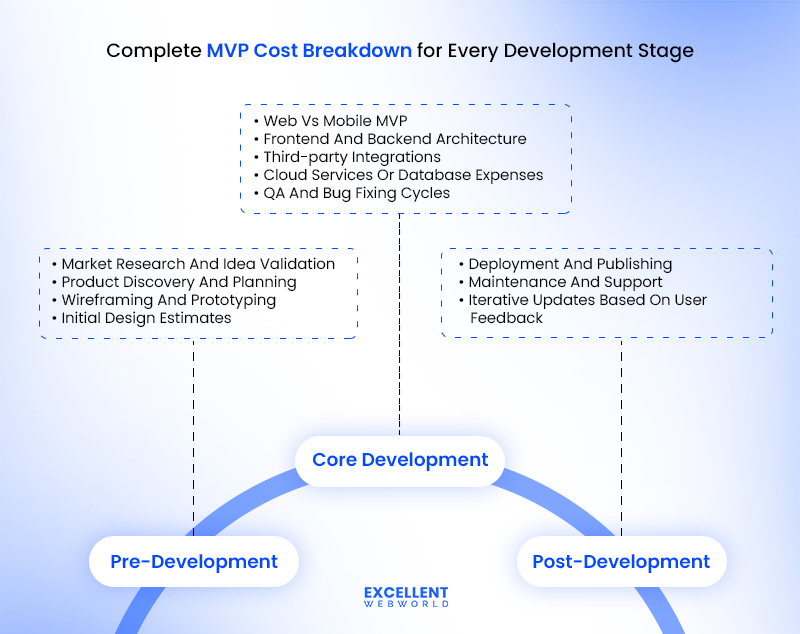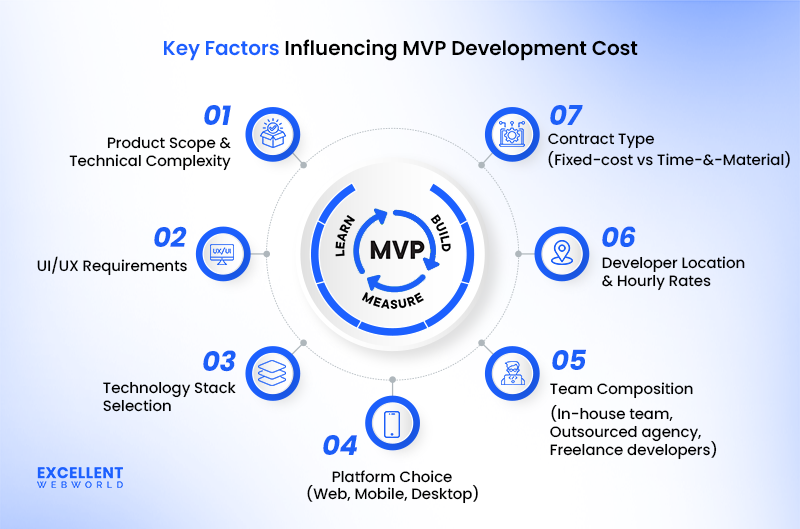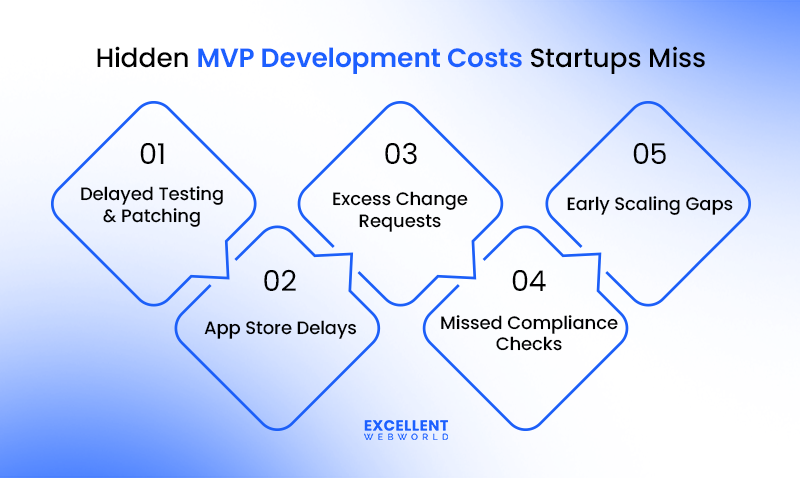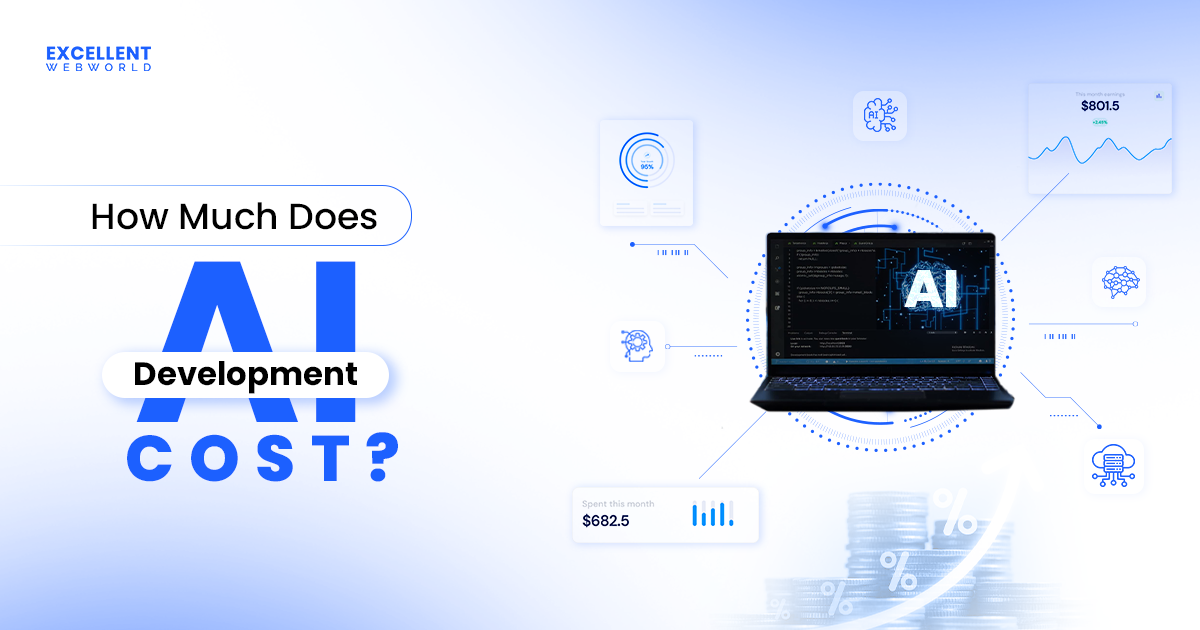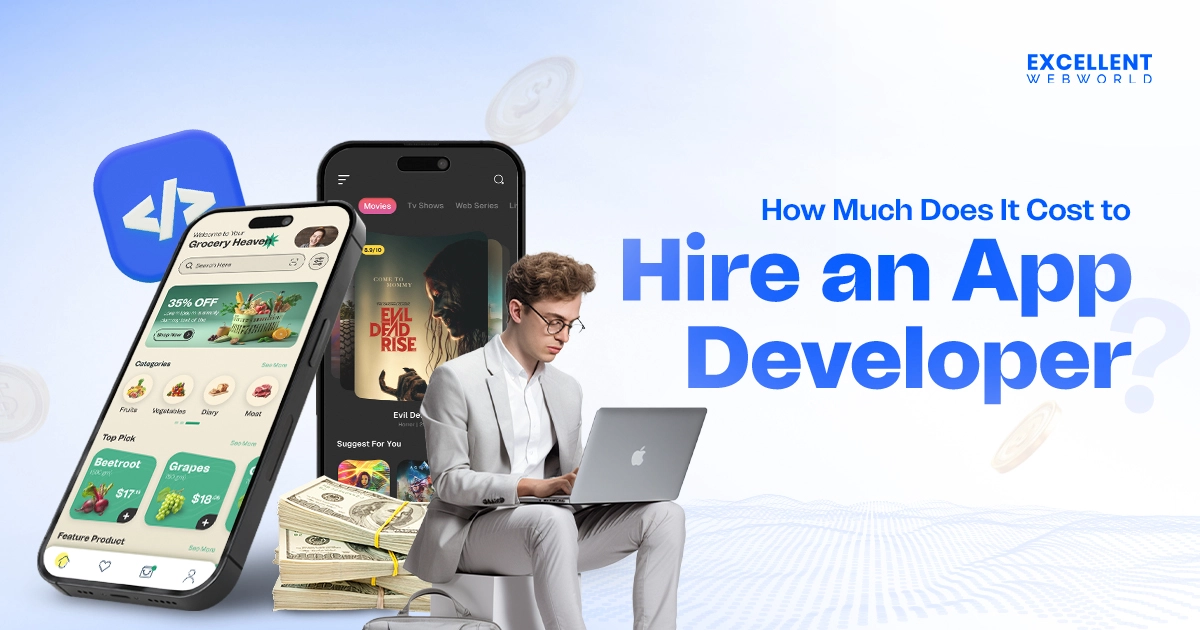If these situations sound familiar while planning your MVP development, then you are not the only one facing them.
And because of these concerns, now you want to know “how much does it cost to build an MVP?” so you can plan your budget accordingly, right?
Many startup founders and enterprises looking to develop internal tools face the same issue. Minimal viable products are meant to validate your idea in a cost-effective way before making major investments.
However, one wrong budgeting decision can ruin everything. Either leave you with an MVP that fails to meet user needs, or drain funds you could have used for growth.
So, let’s break down MVP development cost in detail, along with the factors influencing the cost.
Why Budgeting For MVP Development Is Not Just About Numbers
A clear MVP budget gives clarity on exactly how your time, resources, and technology will be used. It ensures the launch remains financially balanced and ready for future improvements. It also allows teams to avoid costly rework by aligning product goals with available funds right from the start. Check out why budgeting is important.
An accurate budget provides clarity that speeds up decision-making and helps you respond to changes in your product strategy more effectively.
How Much Does It Cost To Build An MVP?
The cost to build an MVP ranges from $14,000 to $44,000+, depending on small agencies or outsourced development teams. Low-code and no-code platforms deliver a basic MVP under $20,000, but scaling the product and customizing advanced features becomes difficult over time.
Why does this cost vary so widely? Just because every MVP is different, whether you are looking to build a conversational AI chatbot or an eCommerce application. A basic social networking app takes fewer resources, but if you want to build an AI app, then it will demand advanced infrastructure and expertise, raising overall costs.
In the same way, choosing between in-house and outsourcing software development impacts the total spend. Let’s help you understand by breaking the cost into 3 phrases:
Now, let’s explore each of the phases in detail to know the MVP development estimation.
1. The Cost Involved Before The Development Phase (Pre-development Costs)
Here is the table with the detailed cost structure of the pre-development stage.
| Activity | What It Covers | Estimated Cost Range | Timeline (Approx.) |
|---|---|---|---|
| Market Research & Idea Validation | $2,500 – $6,000 | 1 – 2 weeks | |
| Product Discovery & Planning | $3,500 – $8,500 | 1 – 3 weeks | |
| Wireframing & Prototyping | $2,000 – $5,500 | 1 – 2 weeks | |
| Initial Design Estimates | $2,500 – $7,500 | 1 – 2 weeks |
The pre-development cost to develop an MVP ranges between $10,500 – $27,500, and the pre-development timeline to build an MVP ranges around 4 – 6 weeks.
Market Research And Idea Validation
Treat this step as your MVP’s first reality check. You do not want to spend months developing something only to realize nobody needs it. The step helps you pinpoint who your users are and what challenges they face. Adding surveys and competitor analysis helps confirm that your product has market demand. Validation early saves thousands of dollars in potential rework.
Product Discovery And Planning
Here, ideas evolve into a structured development roadmap. This session brings decision makers and developers together to clarify scope and priorities. The goal is to create an actionable plan so developers know exactly what to develop and in what order. Clear planning means fewer revisions and controlled expenses.
Wireframing And Prototyping
Wireframes are like blueprints for your MVP, which show how users will interact with your product. Prototypes make it clickable to give you and your team a real feel of the app’s flow. The step helps you spot usability issues early and refine each one before spending on actual coding. This makes it easy for faster delivery and rework cost reduction.
Initial Design Estimates
Design is where your minimum viable product starts looking like a real product. Creating mockups and branding assets gives developers a clear direction to follow. A complete design accelerates software development and prevents mid-project changes that can delay the launch.
2. The Cost Incurred During the MVP Development Phase (Core Development Costs)
This stage focuses on building the functional backbone of your MVP. Here is the table highlighting the detailed cost structure of the development stage.
| Activity | Purpose | Estimated Cost Range | Timeline (Approx.) |
|---|---|---|---|
| Frontend & Backend Architecture | Building a user-facing interface and system logic | $8,000 – $18,000 | 3 – 5 weeks |
| Third-party Integrations | Adding payment gateways, analytics, or APIs | $2,000 – $6,000 | 1 – 2 weeks |
| Cloud Services / Database Setup | Hosting, storage, and data handling | $2,000 – $5,000 | 1 – 2 weeks |
| QA & Bug Fixing Cycles | Ensuring smooth functionality and performance | $3,000 – $7,000 | 1 – 2 weeks |
The core development cost to build an MVP ranges $14,000 – $44,000+, and the core development timeline to build a minimum viable product ranges from 10 – 18 weeks, depending on the complexity and platform choice.
Frontend And Backend Architecture
This is where your MVP comes alive, combining how the frontend and backend work together to deliver a complete product. The frontend focuses on the user experience, while the backend manages the logic and data to ensure performance, functionality, and security. Developing strong architecture upfront ensures your minimum viable product performs well and scales easily as usage grows.
Third-party Integrations
Rather than building from scratch, you can connect pre-built solutions like payment systems, chat APIs, or analytics tools. Using integrations accelerates development and frees up resources to focus on what makes your product unique. The catch is managing licenses and ensuring these tools fit well with your system.
Cloud Services Or Database Expenses
Your MVP needs a reliable hosting environment to store and protect user data. Leading cloud platforms like AWS, Google Cloud, or Microsoft Azure offer reliable hosting and scaling options. The right database choice helps avoid performance issues when user number grows. A wrong choice here means higher costs and slower performance down the road.
QA And Bug Fixing Cycles
Even the simplest MVP required thorough testing. Quality assurance ensures your app functions well on devices, browsers, and network conditions. Early bug resolutions avoid a frustrating experience that might drive users away. Consistent testing cycles help maintain timelines and prevent expensive post-launch fixes.
3. The Cost Involved After the Development Phase (Post-development Costs)
This stage focuses on tasks that keep your MVP functional and relevant after launch. Here is the table containing the cost structure of the post-development stage.
| Activity | What Costs This? (Breakdown) | Estimated Cost Range | Timeline (Approx.) |
|---|---|---|---|
| Deployment & Publishing | Server setup, security certificates, app store fees, configuration & monitoring tools | $1,000 – $5,000 | 1 – 2 weeks |
| Maintenance & Support | Ongoing bug fixes, performance optimization, minor feature tuning, and monitoring tools | $2,000 – $10,000/month | Ongoing |
| Iterative Updates (User Feedback) | Developer hours for new features, QA testing, design adjustments, and API changes | $2,000 – $8,000/update | 1 – 3 weeks/update |
The post-development cost to develop an MVP ranges from $5,000 – $25,000+, and the post-development timeline is ongoing because of updates, bug fixes, and scaling never stop after launch.
Deployment And Publishing
The planning and coding, everything happens here. From setting up servers to integrating APIs and managing app store submissions, this step ensures the product is secure and ready for users. If done right, your MVP launches smoothly and is ready for user testing in real conditions.
Maintenance And Support
Even a perfectly coded minimum viable product demands periodic checks and updates. Once real users interact, technical and usability issues are likely to appear. Regular maintenance keeps your MVP stable and adaptable to new user demands and changing technology requirements. Growing startups underestimate this ongoing cost, which averages 10-20% of annual development costs.
Iterative Updates Based On User Feedback
Early adopters provide the most valuable feedback for product improvements. Updates after launch help fine-tune features, improve user flows, and remove friction points, aligning your product with user expectations. Such iterations keep your MVP relevant and prepare it for scaling without technical debt piling up.
While these cost phases give you a rough idea, the actual spends depend on external and internal factors. Let’s check each of the factors influencing MVP development cost in detail.
Major Factors That Influence MVP Development Pricing
Understanding the factors influencing the minimum viable product development cost helps in setting a realistic budget and avoiding unexpected expenses. Here are the factors explained in detail.
1. The Scope And Complexity Of Your MVP
| MVP Complexity Level | Typical Features Included | Estimated Cost Range | Timeline (Approx.) |
|---|---|---|---|
| Basic MVP | Core features only, single platform, minimal integrations | $14,000 – $24,000 | 10 – 12 weeks |
| Medium Complexity MVP | User dashboards, payment gateway, push notifications, APIs | $24,000 – $34,000 | 14 – 16 weeks |
| High Complexity MVP | AI/ML features, multi-user roles, advanced security, cross-platform support | $34,000 – $44,000+ | 16 – 18 weeks |
Complexity raises costs because every additional feature adds more interconnected components to manage. A simple MVP might need one small development team, but once you add multiple user types and security layers, you need specialists and a strong infrastructure. Every layer of complexity slows development and makes small tweaks affect more parts.
Another critical factor is the learning curve and the unknowns. For example, adding machine learning or multi-factor functionalities involves specialized skills and extra research efforts. As a result, more hours and premium talent rates drive up total development costs. You must define a clear scope at the start to prevent scope creep and unexpected budget spikes.
2. The Level Of Design You Aim For (UI/UX Requirements)
| Design Task | Estimated Cost Range | Timeline (Approx.) |
|---|---|---|
| User Research & UX Strategy | $2,000 – $5,000 | 1 – 2 weeks |
| Wireframing & Low-Fidelity Prototypes | $1,500 – $4,500 | 1 – 2 weeks |
| UI Design (High-Fidelity Mockups) | $2,500 – $10,500 | 2 – 4 weeks |
| Interactive Prototypes & Micro-interactions | $2,000 – $8,000 | 1 – 3 weeks |
The quality of your MVP’s design decides whether users find it usable and worth returning to. Smooth onboarding through engaging design ensures that first-time users do not abandon your product early. However, detailed research and premium visual elements come at a higher cost and also take longer to deliver.
For most early-stage MVPs, focusing on clear user journeys, basic branding, and usable screens is sufficient. Premium animations and full-scale design systems are better investments after launch, once you know how users engage with your product.
3. How You Select The Technology Stack
| Technology Decision | Purpose | Estimated Cost Impact | Notes |
|---|---|---|---|
| Frontend Framework Choice | React, Vue, Angular, etc., for building UI | $5,000 – $18,000 | Influences speed & scalability |
| Backend Framework & Language | Node.js, Python, Java, PHP for server-side logic | $7,000 – $20,000 | Impacts the complexity of integration |
| Database & Cloud Infrastructure | MySQL, MongoDB, AWS, GCP, Azure for storage & hosting | $2,000 – $10,000 | Affects hosting & scalability costs |
| Cross-platform vs Native (Mobile) | Flutter/React Native vs separate iOS & Android apps | 20 – 30% cost difference | Cross-platform saves cost but may limit advanced features |
Your choice of technology stack directly affects how fast your MVP can be built, how easily it scales, and how expensive it is to maintain. Using proven, widely adopted software development frameworks often means faster development and easier hiring, while niche or highly specialized tech can increase both cost and risk.
For mobile apps, choosing cross-platform frameworks like Flutter or React Native can cut development time by up to 40% compared to separate native builds, but might compromise performance for very feature-heavy apps.
The backend and database decisions also matter. For example, opting for a serverless architecture (AWS Lambda, Firebase) reduces infrastructure management costs initially but may increase costs as traffic grows. Picking the wrong stack can result in technical debt, forcing expensive rewrites later.
4. Platform Choice: Web, Mobile, or Both?
| Platform Option | Use Case Example | Estimated Cost Range | Timeline (Approx.) |
|---|---|---|---|
| Web MVP (Single Platform) | SaaS dashboards, booking systems | $14,000 – $35,000 | 10 – 12 weeks |
| Mobile MVP (Single OS) | iOS or Android only (native or hybrid) | $24,000 – $54,000 | 14 – 16 weeks |
| Cross-Platform Mobile MVP | Flutter/React Native for both iOS & Android | $34,000 – $60,000 | 16 – 18 weeks |
| Web + Mobile (Multi-Platform) | Combined web portal and mobile apps | $44,000+ | 16 – 18 weeks |
The platform you choose to launch on affects not only cost but also how quickly you reach your audience. Building a web MVP is usually the fastest and least expensive way to validate your idea, making it popular for B2B tools or early consumer apps. Mobile-first MVPs are essential when your audience primarily interacts via smartphones, like fitness apps or on-demand delivery platforms.
Going cross-platform with frameworks like Flutter or React Native allows you to release for both iOS and Android simultaneously, saving up to 30–40% in cost compared to building separate native apps. However, if your app requires heavy device-specific functionality (like AR, complex Bluetooth interactions, or advanced animations), native development or a phased approach may be better.
5. Development Team Composition
| Team Type | Key Characteristics | Estimated Hourly Rate (Average) | Ideal For |
|---|---|---|---|
| In-House Team | Full-time employees, direct control, high overhead | $90 – $150/hr (US/Europe) | Companies with a long-term roadmap |
| Outsourced Agency (Offshore/ Nearshore) | Dedicated team from an external company, scalable resources | $35 – $70/hr (Eastern Europe, Asia) | Startups needing expertise & speed |
Hiring An In-House Team For MVP Development
An in-house team gives you direct control over the software development process, seamless collaboration, and quick iterations. However, it comes with a significant financial burden, including salaries, benefits, workspace costs, and recruitment expenses.
This model works best for businesses with a long-term product roadmap and the financial stability to support ongoing development after the MVP phase. For startups operating on tight budgets, this option is often considered too heavy an investment for early validation.
Outsourcing an MVP Development Agency
Partnering with an experienced MVP development agency, provides instant access to diverse expertise, from product strategy and UI/UX design to backend architecture and deployment support. Agencies work on defined milestones to ensure faster delivery without the overhead of hiring full-time staff.
If you choose our team, you get access to developers who specialize in building MVPs optimized for speed and scalability. As a recognized AI-driven mobile app development company, Excellent Webworld works on a lean approach. Such an approach helps you prioritize features, avoid unnecessary costs, and deliver a market-ready MVP within defined timelines and budgets.
6. Developer Location And Hourly Rates
Location is one of the biggest drivers of MVP pricing because developer hourly rates vary significantly across regions. A team in the United States or Western Europe commands premium rates due to higher living costs and demand for local expertise. Eastern Europe and parts of Asia offer highly skilled developers at a fraction of the cost, making them popular destinations for startups aiming for cost-effective MVP development without compromising quality.
| Region / Location | Average Hourly Rate (Developers) | Typical MVP Pricing Range |
|---|---|---|
| United States & Canada | $90 – $150/hr | $70,000 – $140,000+ |
| Western Europe (UK, Germany, France) | $70 – $120/hr | $60,000 – $110,000+ |
| Eastern Europe (Poland, Ukraine, Romania) | $35 – $70/hr | $35,000 – $70,000 |
| Asia (India, Vietnam, Philippines) | $20 – $50/hr | $25,000 – $50,000 |
| Latin America (Brazil, Argentina, Mexico) | $30 – $55/hr | $30,000 – $60,000 |
However, choosing based solely on low cost can be risky. Time zone differences, language barriers, and cultural misalignments can affect communication and project delivery. Many startups choose nearshore or offshore outsourcing, where they can balance cost savings with real-time collaboration and proven development processes.
7. Contract Type (Fixed-cost Vs Time-and-Material)
The way you structure your development contract influences your cost for MVP development.
Fixed-Cost Contracts
Fixed cost contracts are best suited when your MVP scope is well-defined and stable. The biggest advantage is predictability, both in budget and timeline. Since the deliverables are agreed upon upfront, you know exactly what you are paying for. The downside is flexibility. If you need to add or modify features mid-development, it means renegotiating the contract or paying additional fees.
Time-and-Material (T&M) Contracts
This model is more flexible and supports iterative software development. You pay for the actual time and resources used, which works well if your MVP features are expected to evolve based on user feedback or market validation. The risk is budget unpredictability. Without careful oversight, costs quickly escalate.
The choice of contract type impacts cost stability and flexibility. Fixed cost gives certainty but restricts change, while time nd material support adaptability but requires tight financial control.
Tips To Reduce Your MVP Development Cost Without Compromising Quality
Here are the tips you need to consider if you want to reduce the cost of MVP development without compromising quality.
1. Prioritize Only The Features That Support Initial Validation
Adding unnecessary features leads to more effort in design, development, and testing, driving up expenses. Concentrate on core functionalities that showcase the product’s value. For example, if you are developing a marketplace MVP, start with basic product listing and payments. Advanced analytics or recommendation engines wait for later iterations.
2. Follow A Lean Development Approach With Defined Sprint Goals
Dividing the entire development process into small, goal-focused sprints helps you prevent wasted efforts on misaligned features and functionalities. Following lean practices helps deliver quickly and cut down on expensive redesigns later on.
3. Integrate Open-Source Tools That Meet Core Requirements
Open-source frameworks and prebuilt integrations reduce the requirement to build the MVP from zero. For example, using plug-and-play modules for payments or analytics speeds up development and maintains security standards.
4. Outsource To Regions With Competitive Rates & Proven Track Records
A skilled app development team from cost-effective regions (like Eastern Europe or Asia) can deliver the same quality at a fraction of the cost compared to the US or Western Europe. Make sure you choose a reliable app development company with expertise in development and a strong portfolio.
5. Avoid Building Complex Architecture For Early-Stage MVPs
Your MVP does not need the same level of scalability as a fully mature product. So, skip complex microservices or multi-cloud deployment in early versions. Simple architectures are enough for early validation and help control the overall development cost as well.
Hidden Costs In MVP Development That Most Startups Overlook
Here are the hidden costs you need to know, even if you are a growing startup or an established enterprise.
1. Delayed Testing & Missed Patches
Many startups under-budget quality assurance, assuming a smaller product won’t face major bugs. However, even a basic MVP can create complex interactions, specifically with third-party integrations. Neglecting QA means bugs go live, damaging user experience, and requiring costly emergency patches.
How to avoid it
You need to include testing in every sprint and allocate at least 20-25% of total development hours for quality assurance.
2. Ignoring Compliance & Legal Checks
Smaller teams and startups overlook compliance initially. In sectors like healthcare and fintech, ignoring regulations (HIPAA, GDPR, PCI-DSS) causes heavy penalties and forces costly re-architecture later. Strong compliance practices build trust among early users and investors.
How to avoid it
Map out all compliance requirements during the planning phase and work with legal experts before development begins.
3. App Store Rejections & Approval Delays
In some cases, minimum viable products face rejection for violating App Store or Google Play guidelines, like missing privacy policies, improper permissions, or mobile app crashes. Each rejection adds delays and requires urgent fixes, which again increases development costs and timelines.
How to avoid it
Conduct compliance checks before submission and thoroughly review platform-specific guidelines and rules.
4. Frequent Change Requests During Sprints
Constant changes during sprints require reworking completed tasks and adding extra development hours. This slows down sprint velocity, raises costs, and delays the launch schedule, which affects MVP goals.
How to avoid it
You need to finalize sprint features beforehand and maintain a backlog for future changes instead of immediate additions.
5. Poor Planning For Early-Stage Scaling
Many MVPs focus only on proof of concept and ignore scalability, relying on free-tier servers or fragile architecture. Scaling later on costs around 2-3x more than developing on a flexible foundation from the start.
How to avoid it
Just adopt flexible cloud hosting and modular architectures to support user growth without costly re-engineering.
How Long Does It Take To Build An MVP?
The time it takes to build an MVP is around 1-6+ months, depending on various factors like complexity and tech stack. A simple MVP with basic functionality may be launched within a few weeks, while multi-platform products with AI capabilities require more time. Let’s check out the timeline.
| MVP Complexity | Key Features Included | Estimated Timeline |
|---|---|---|
| Simple MVP | Core features only (e.g., user login, basic UI, simple backend) | 1 – 3 months |
| Average MVP | Custom UI/UX, third-party integrations, multi-role support | 3 – 6 months |
| Complex MVP | Multi-platform support, advanced features, AI, or analytics | 6+ months |
Still, these timelines vary based on several other factors apart from features. Here are all the factors that influence the MVP development timeline.
Now, let’s check out the most popular examples of MVPs, which are now global giants.
Examples Of Minimum Viable Products That Started Small And Succeeded
Here is an overview of the top examples of MVPs that are now recognized as successful global businesses.
| Startup | Initial MVP Focus | Development Approach | Growth |
|---|---|---|---|
| Airbnb | A simple website listing their apartment | Built in-house, basic web app | Now a global vacation rental giant |
| Dropbox | Demo video showing concept functionality | Focused on concept validation | Became a leading cloud storage platform |
| Uber | Basic app connecting riders and drivers in SF | Outsourced initial app development | Expanded into a global ride-hailing giant |
| Photo sharing with filters, iOS only | Lean mobile-first MVP | Acquired by Facebook for $1B |
These are perfect cases of a Lean startup approach, where MVPs were built to validate ideas quickly and cost-effectively. Other startups began with small-scale MVPs and evolved into industry leaders. You can explore such examples to get practical insights into how you approach your own MVP strategy.
How To Choose The Right Team For MVP Development
Here is the entire process to choose the right development team for your minimum viable product.
1. Check MVP Portfolio & Relevant Case Studies
Before trusting a team with your MVP, check if the team has experience in delivering similar products with your desired requirements. What you can do is:
If their history shows time, cost, and resources used efficiently, then don’t let them go. They are likely a good fit for your MVP requirements.
2. Evaluate Technical Communication & Transparency
Clear communication prevents costly delays and misaligned expectations during MVP development. Without transparent updates, timelines go off track. Get answers for the following questions:
When your team communicates openly, trust builds naturally. Also, the unexpected delays are minimized.
3. Assess Development Process & Agile Adaptability
MVPs change as user feedback comes in. You don’t require a team that waits until the end to show progress. You require a team that adapts fast rather than sticking to rigid processes. If you know, Agile-friendly teams are faster and more flexible:
Green flag: If the MVP vendor shows you sample sprint reports or early prototypes from past projects, it means they are used to iterative development.
4. Balance Development Cost With Long-Term Scalability
At first, you might feel cheap development is appealing and effective, but most of the time, it results in expensive rework later. Instead, aim for effectiveness and scalability. What you can do is look for answers to these questions:
Tip: When evaluating a team or agency for MVP development, ask: “How would you handle scaling if we grow to 50,000 users in six months?” Their answer to this query will reveal their readiness for growth.
5. Review Post-Launch Support & Flexibility
Your MVP launch is not the finish line. It is the starting point for growth and iterations. The right team must stay committed beyond delivery. If you opt for reliable teams, they must:
You can also ask for their support policy and examples of how they handle post-launch partnerships with clients.
Find The Best Minimum Viable Product Cost Strategy For Your Startup
Budgeting smartly for your minimum viable product is less about controlling cost and more about ensuring your product is market-ready without unnecessary complexity. A structured MVP approach helps you launch faster, validate ideas with real users, and secure funding for the next phase of the product.
Why partner with Excellent Webworld for MVP development?
If you are a startup founder who wants to create an MVP & prototypes or want a clear cost strategy to match, reach out to our experts today. Let’s turn your idea into a minimum viable product that users love and investors support.
Frequently Asked Questions
Limit the MVP to only those features and functionalities that validate your core ideas and skip non-critical features in the first release. Also, what helps you cut costs while keeping quality is to use open-source frameworks, adopt a lean development approach, and partner with an experienced MVP development company.
Start by defining the purpose of your product, expected workflows, and must-have features. Most of the MVP agencies run discovery workshops to refine your idea into detailed requirements, which allows for accurate cost projections even without complete documentation.
Freelancers are a good option for small MVPs but lack established processes and diverse expertise. Agencies provide complete teams and end-to-end support, which makes them ideal for startups that plan to scale or need faster MVP development without worrying about the cost.
You can start lean by focusing on must-have features and scheduling additional functionality for post-launch iterations. Adopt open-source solutions and cloud-based services while using cross-platform development to save both time and cost.

Article By
Paresh Sagar is the CEO of Excellent Webworld. He firmly believes in using technology to solve challenges. His dedication and attention to detail make him an expert in helping startups in different industries digitalize their businesses globally.

